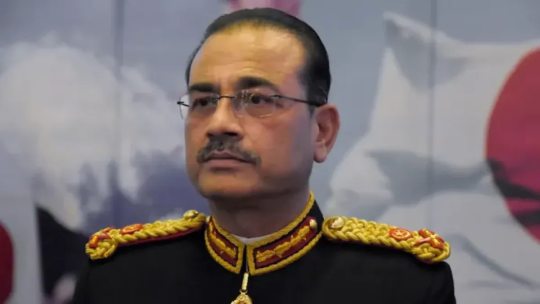#remodel Inter-Services Public Relations
Text
Pakistan Army seeks to remodel military’s media wing ISPR to boost its image: Reports
Pakistan Army seeks to remodel military’s media wing ISPR to boost its image: Reports
Following a change of command in the Pakistan Army, the focus of senior military personnel has shifted to improve the image of military’s media wing Inter-Services Public Relations (ISPR), reports have said.
Karachi,UPDATED: Dec 29, 2022 19:28 IST
General Asim Munir, a former ISI head, assumed charge as the Pakistan Army chief in November (Photo: AP/File)
By Subodh Kumar: The Pakistan Army has…

View On WordPress
#Army#boost#image#Inter-Services Public Relations#ispr#ispr image building#media#militarys#pak army to improve image of Inter-Services Public Relations#Pakistan#pakistan army#pakistan military media wing#remodel#remodel Inter-Services Public Relations#reports#seeks#wing
0 notes
Text
What I want more of...
Linking Theory and Great Man History documents from the DRC about the Kings are all well and good, but at this point, I want to know more about the nitty-gritty socio-anthropological stuff. Like:
What kinds of clothes did the D’ni wear? What were the fashions of the day at the time of the Fall? How did styles change in the past? We have precious few examples of D’ni clothing (and even fewer of women’s clothing…), and almost all of it is from just before or well after the Fall, in circumstances that are largely outside the normal everyday life of the average D’ni person. Did they wear robes and/or tunics in more casual settings, or was the sort of button-down attire that Gehn wears the standard? Were women allowed to wear pants? What were the social norms on jewelry, and what did it look like?
What were D’ni hair styles like? Again, about all we really have to go on is Atrus, Gehn, and Aitrus. The only D’ni woman we’ve ever seen (not counting Yeesha since she’s… unique) is a portrait of Lalen, and her hair is entirely obscured by her head dress. Was long hair on men seen as acceptable? What sorts of haircuts did they wear (clearly Albert Einstein hair was fine for Aitrus…)? Did women always wear head coverings like Lalen’s, or was that just an historical style / professional attire for a prophetess? Was long or short hair more common/acceptable for women? If they had long hair, did they wear it straight, or did they go full Roman Empire with Big Hair and wild braids?
What was D’ni architecture like? We have a handful of examples in Uru and assorted concept art for the same, but the game shows a pretty narrow slice, and the concept art has no dating to help establish movements or periods. We also only really have visibility into public infrastructure-type structures like transportation hubs and museums. What did everyday D’ni houses look like? What were the mores surrounding families and inter-generational cohabitation? How acceptable was it to share an apartment with someone you weren’t related to? What about if you weren’t married? How rapidly did architectural styles change, and how did they break down along class lines? How did they memorialize their dead, or commemorate important locations or events in the Cavern / other Ages? Did they habitually remodel old structures, or raze them and build up from scratch? How much was built into the rock as opposed to being free-standing, and how did the interior styles for those modes of construction differ? How did the D’ni convey meaning and symbolism through their architecture (e.g. if the Temple of Yahvo is supposed to glorify that deity, how does it go about doing so)? How did that change over time?
Bathrooms.
How did the D’ni treat the disabled? The Cavern is pretty ADA-noncompliant; how did people get around if they were impaired or paralyzed? How advanced was their medical system (they had germ theory, at least)? How well did they care for those with mental disabilities or illnesses?
Were there LGBT people in D’ni? How did that go?
What was D’ni schooling like for those outside of the guild system? Was there a mandatory, public education system like we have up here, and how far did that carry people? What sorts of work was available to those without a guild education? Was it mostly house work for the upper classes and service industry jobs like bartending? How were servants treated/compensated for their work? Given how socially stratified D’ni culture seemed to be, how much upward mobility was there? Considering how patriarchal D’ni society was, what opportunities were there for women? They were eventually allowed to join the minor guilds, and there’s several mentions of actors and prophetesses, but were they allowed to be teachers? Bankers? For that matter, what exactly happened to the prophetesses after Kerath abdicated the throne?
Speaking of religion, what exactly was the Cult of the Tree’s deal? What were the Temples of Stone and Water for? How did the D’ni worship, and what were their rituals? Were there organized masses? Was there a public daily prayer cycle? Or was it a more personal and private affair? How did chambers like the “egg room” in the Neighborhood (which is really a set of meditation rooms built around a depiction of the Seed of the Tree of Possibilities as far as I can tell) factor into worship and other rituals? How exactly do you get to a point where there are 2,500 distinct cults in a population of maybe a million people (working from Atrus’s estimates in BoD), especially when they seem to have so much of the rest of their culture in common? What were those cults’ beliefs and practices? Did they believe in other gods than Yahvo? If so, were any of those groups polytheistic, and what was their pantheon like? If not, what did they worship or revere?
We know the Guild Council ruled over D’ni, but what were the day-to-day politics like, both inside and outside those walls? What sort of authority did the government have? What was the scope of its powers, and who/what was responsible for codifying and enforcing that scope? How did the lower classes handle this sort of highly non-representative government? Was there unrest? Were there ever attempts at revolution after the time of the kings? Just what sorts of reforms were Aitrus and Ti’ana pushing for just before the Fall?
Can we have more punctuation symbols than a period and a hyphen? What symbols and visual layout did the D’ni use to do math? Do you think they ever left the boxes out of their number writing because it was just super tedious?

53 notes
·
View notes
Text
Entrepreneurs, markets, and advertisements worldwide are constantly jumping into a mobile marketing advertisement, so without being aware of it you should be aware of this opportunity for marketing and use it for your benefit.
Entrepreneurs, markets, and advertisements worldwide are constantly jumping into a mobile marketing advertisement, so without being aware of it you should be aware of this opportunity for marketing and use it for your benefit 1080 porn videos The discussion below is a brief talk about how to start a good conversation. As far as mobile market changes are concerned, now there is a common formula for many companies and companies to use interactive campaigns, called crawling, walking, running. When pushed up, this means the business should come up with a specific strategy to send text messages to the target audience. This strategy is linked to a number of factors, including the type of business involved, targeting the target audience, and most of the different types of businesses that want to build. To succeed, your company must have a short number of regular telephone numbers that are regularly represented by the official telephone number. Make sure that this shorter number can be easily mapped to customers and not as powerful as the sound of other companies. It's interesting to note that the short-term business laws are very expensive, meaning that all types of businesses can now join marketing issues. If your company is small, medium-sized or larger, mobile service providers now offer a variety of resources to hire a special telephone number that displays your brand and promotion of products and services. The second part of the text message text message is on. By walking, this means that the target audiences should be reminded of the mobile version of anywhere they go. This is where it is possible to integrate with other promotional and promotional strategies. You can print printed publications on private newspapers, magazines, and magazines to appreciate readers and invite them to send a message to your mobile number. You can collaborate with bulk carrier public areas, from train stations to schools to build shops and so forth. Why it is important to know what your target audiences are and what kind of tools they are reading. When it comes back to the appearance of your mobile phone mobile phone campaigns and traditional media channels, they will be incredibly exciting and eventually join your mobile phone service on a voluntary basis. The third and final version for a large number of campaigns is ongoing. This means you have the ability to target your target audience after your campaign. This can be done through inter-agency experience. At this time and join your invitation to your move, keep them happy with providing reward, treatment, and remodeling your text messages. For example, you can send a message to you to visit on your website. This site will provide a modern, technology, and communication system that deals with games, questions, and related products and services. You can also use the text message to present events for future companies and present them and offer special offers, cheaper receipts, and free offerings, and so forth.
0 notes